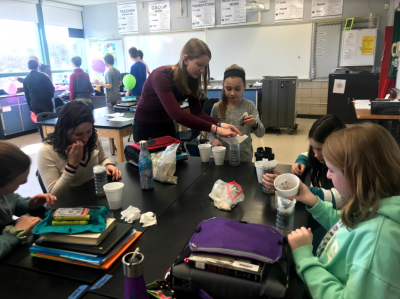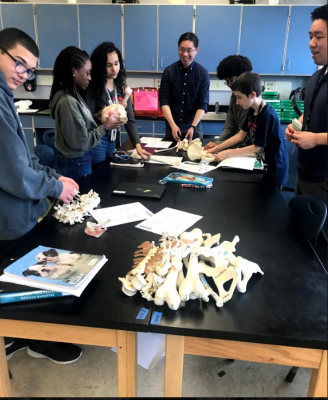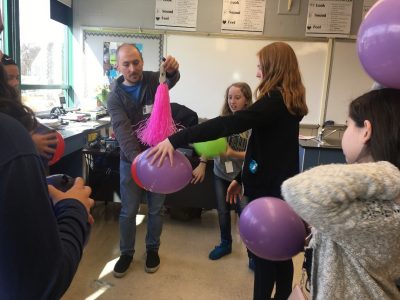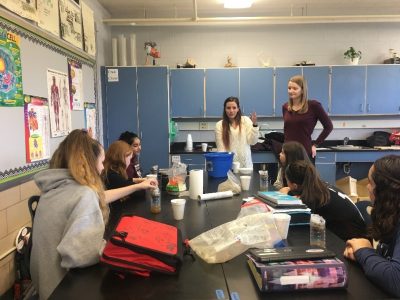
Congrats to Joule Fellow Diane Walsh for getting her lesson plan published on Teach Engineering. To learn more about the activity click here.

Congrats to Joule Fellow Diane Walsh for getting her lesson plan published on Teach Engineering. To learn more about the activity click here.
Run by graduate students from various departments within the University of Connecticut School of Engineering, the John Lof Leadership Academy aims to train its members to become leaders in their fields. The Academy provides training and workshops focused on leadership through the lens of the individual member’s career and personal goals. Through that training, Academy members focus their time on honing their skills through practice, which is done through collaboration and outreach.
As part of that goal rooted in outreach, the Lof Scholars visited Illing Middle School in Manchester, Connecticut on March 25. The Lof scholars spent the day talking about UConn and our engineering programs and sparked students towards the field of engineering through the use of fun, active learning.
Throughout the day, the Lof Scholars worked with over 150 students. Students learned how to make water filtration apparatuses, they studied biomechanics using a human skeleton and learned about electromagnetics, which introduced them to the fields biomedical, electrical, environmental, civil, chemical, and mechanical engineering. The Lof scholars found the opportunity very rewarding as they were able to bring their research to kids in a fun and interesting way.






October 4, 2018
Joule Fellow: Diane Walsh
September 13, 2018
News:
Conn. Teachers Can Apply for $5000 in Classroom Support
Elementary and middle-school teachers in Connecticut are invited to apply for a $5,000 gift through the Rogers Educational Innovation Fund, beginning Sept. 15.
The deadline for submissions is Nov. 15, 2018.
April 30, 2018
Joule Fellow: Heidi Douglas
The Center for Learning with Nature, a non-profit devoted to helping teachers integrate Nature-oriented innovation and STEM learning into their classrooms, is looking for 4th and 5th-grade teachers interested in piloting the new Engineering Inspired by Nature kit.
For more details and how to apply, click here or https://docs.google.com/forms/d/e/1FAIpQLSfBbVewVgBuSwLY6_pXz_RXdXadHghci84rOl-ch6f0GoqLwg/viewform?pli=1
Applications are due by May 15. Please feel free to forward this on to teachers you think may be interested.
April 5, 2018
Joule Fellow: Lynn Olson
Dr. Hoshino’s students visiting my class at Howell Cheney Technical High School. Two of the pictures are from this fall, 2017. The class photo was from the fall of 2016. Dr. Hoshino’s students also visited my classes in the fall of 2015.

January 29, 2018
Joule Fellow: Tammy Cohen
This is a video 2 students made of a chemical reaction – the change happens at the end. I did this as part of the DaVinci program as part of the hydrogen fuel cell car project. Students “engineer” the reaction to proceed faster and then slower. I was unaware of this reaction until I participated in the Joule and DaVinci programs.
I still have students do the solar cell engineering project where they maximize and minimize current, voltage, and power using multimeters, LED lights, small motors, and small incandescent lights. I wish I had more pictures, but I really need 100% of my attention on my students during lab activities and really can’t risk taking my eyes off them even for the moment it would take to snap a quick picture.
August 4, 2016
Joule Fellow: Sandra Nichols
Joule Fellow Experience
This summer we had the unique privilege of being part of the Joule Fellows Program sponsored by UCONN Department of Engineering and a grant funded by NSF. The fellowship not only partnered us with other teachers from all over Connecticut but also allowed us to take part in an engineering research program at the Biomechanics department.
Under the direction of Dr. David Pierce and the guidance of our Joule Buddy, Ph.D. candidate Franz Maier, we worked intensely in the Interdisciplinary Mechanics Laboratory. Our fellowship exposed us to current research being done on the biomechanics of cartilage. We witnessed the effects of triaxial shearing of cartilage and experienced the methodical development of protocols.
While the specifics of this research are beyond the scope of our curriculum, we found many valuable take away experiences to share with our students. Being Joule Fellows enriched our understanding of the Next Generation Science Standards such as asking questions and defining problems, planning and carrying out investigations, and analyzing and interpreting data. Overall we have a better grasp on how to develop lessons that break down real-world problems into smaller tasks solved through engineering.
In addition, the Joule Fellowship allowed us to collaborate, communicate and use new cutting-edge technology. During the school year, there isn’t enough time to practice these 21st-century skills to the depth that this experience allowed for us. For example, we are currently designing a lesson about tensegrity to be submitted to the Teach Engineering website even though we teach in different districts and at different levels. This is possible because we had time for in-depth discussions of cross-cutting concepts that apply.
The lesson includes the use of video clips set in a genuine research lab as well as having students create models to represent the mechanics of the knee joint. Students will be asked to design, build and test their models to simulate real-life injuries. By applying engineering processes, students will not only better understand the effects of tension and compression on the knee, but will also gain valuable insight into how engineers use research to address real-world problems. Students will apply their understanding to make predictions and offer solutions to problems that they themselves may face.
We are excited to bring these new ideas not only to our classrooms but to our districts as well. We greatly appreciate the rich learning opportunities our Joule Fellowship generated for us. We will highly recommend this program not only to fellow science teachers but other staff as well.
September 15, 2014
K12GrantsWorkshopHandouts
Joule Fellow: Peter Watson